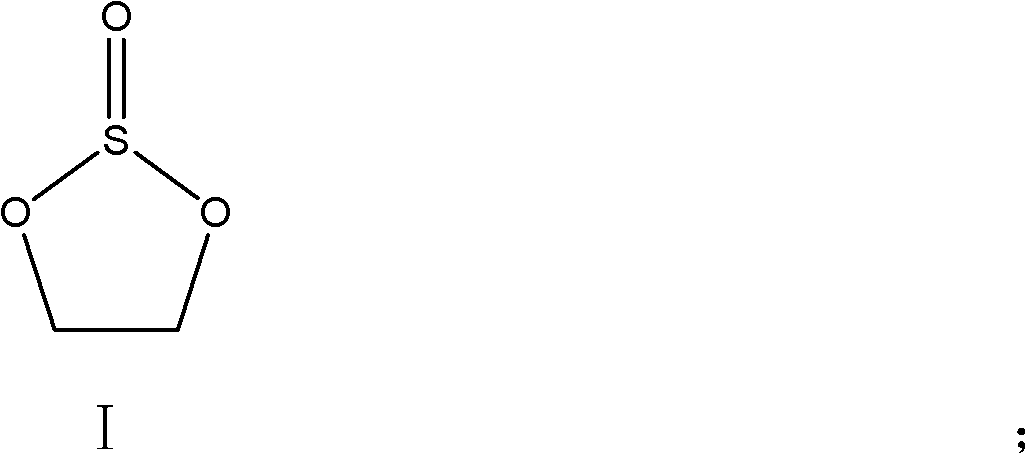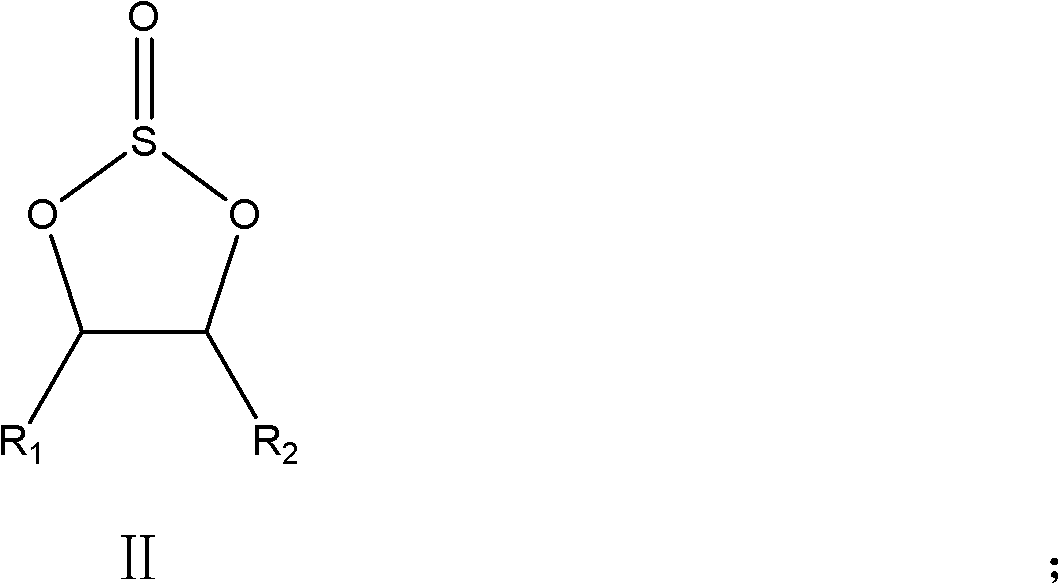Electrolyte
An electrolyte and organic solvent technology, applied in the field of electrolyte, can solve problems such as poor cycle performance and rate performance, achieve stable performance, improve compatibility, and broaden the effect of temperature adaptation characteristics
- Summary
- Abstract
- Description
- Claims
- Application Information
AI Technical Summary
Problems solved by technology
Method used
Image
Examples
Embodiment 1
[0057] An electrolytic solution, wherein the components of organic solvent and additive and their mass percentages are respectively: 20% ethylene carbonate, 50% ethyl methyl carbonate, 30% butenyl sulfite, lithium difluorooxalate borate (LiODFB) in The concentration of the substances in the electrolyte is 1mol / L; under the protection of argon, the electrolyte for testing is prepared in the glove box according to the above ratio.
[0058] Assemble 10 sets of button batteries, and carry out charge and discharge tests on the 10 sets of button batteries at a current density of 0.1C through a blue electric battery test system at room temperature. After 10 weeks of testing, the button battery has an average capacity of 354mAh / g.
[0059] In addition, 10 sets of button batteries were assembled, and the charge and discharge tests were carried out on the 10 sets of button batteries at a current density of 0.1C by a blue battery test system under low temperature conditions (-20°C). Aft...
Embodiment 2
[0061] An electrolytic solution, wherein the components of the organic solvent and additives and their mass percentages are respectively: 30% ethylene carbonate, 69.5% dimethyl carbonate, 0.5% propylene sulfite, lithium diacetate borate (LiBOB) in the electrolytic solution The concentration of the substances in the solution is 0.6mol / L; under the protection of argon, the electrolyte solution for testing is prepared in the glove box according to the above ratio.
[0062] Assemble 10 sets of button batteries, and carry out charge and discharge tests on the 10 sets of button batteries at a current density of 0.1C through a blue electric battery test system at room temperature. After 10 weeks of testing, the button battery has an average capacity of 243mAh / g.
[0063] In addition, 10 sets of button batteries were assembled, and the charge and discharge tests were carried out on the 10 sets of button batteries at a current density of 0.1C by a blue battery test system under low tem...
Embodiment 3
[0065] An electrolytic solution, wherein the organic solvent and additive components and their mass percentages are: 25% ethylene carbonate, 55% diethyl carbonate, 20% vinyl sulfite, lithium perfluoroalkylsulfonimide (Li(CF 3 SO 2 ) 2 N) The concentration of the substances in the electrolyte is 1mol / L; under the protection of argon, the electrolyte solution for testing is prepared in the glove box according to the above ratio.
[0066] Assemble 10 sets of button batteries, and carry out charge and discharge tests on the 10 sets of button batteries at a current density of 0.1C through a blue electric battery test system at room temperature. After 10 weeks of testing, the average capacity of the button cell was 287mAh / g.
[0067] In addition, 10 sets of button batteries were assembled, and the charge and discharge tests were carried out on the 10 sets of button batteries at a current density of 0.1C by a blue battery test system under low temperature conditions (-20°C). Afte...
PUM
 Login to View More
Login to View More Abstract
Description
Claims
Application Information
 Login to View More
Login to View More - R&D
- Intellectual Property
- Life Sciences
- Materials
- Tech Scout
- Unparalleled Data Quality
- Higher Quality Content
- 60% Fewer Hallucinations
Browse by: Latest US Patents, China's latest patents, Technical Efficacy Thesaurus, Application Domain, Technology Topic, Popular Technical Reports.
© 2025 PatSnap. All rights reserved.Legal|Privacy policy|Modern Slavery Act Transparency Statement|Sitemap|About US| Contact US: help@patsnap.com



